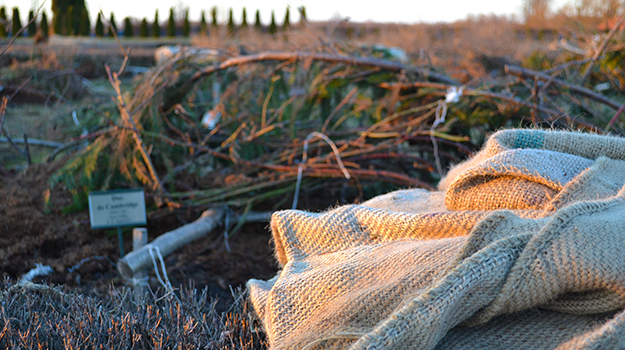
In winter, cold winds and frost can cause real damage to the most sensitive plants. The annuals have died off, and many of the perennials may have a hard time. Even the most tolerant species will appreciate a little help getting through the cold season.
When should winter protection be installed?
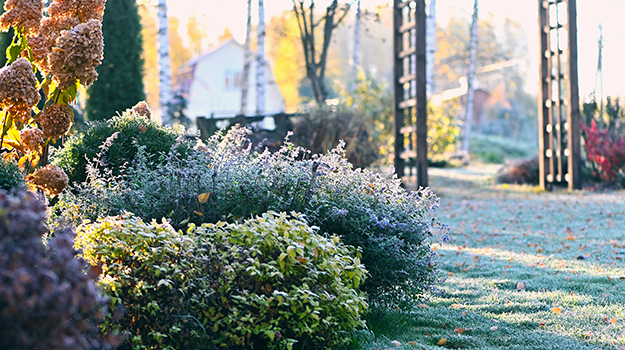
Install your winter protection as late as possible, ideally once the ground has frozen and the leaves have fallen, or even after a good snowfall. Doing this later will prevent your plants from heating up if there are sudden temperature changes that could cause them to come out of hibernation. You can delay putting up the covers, but the stakes should be hammered in before the ground is too hard.
To keep the garden pleasant to look at, we suggest using natural or plant-based materials when possible (mulch, conifer branches, wooden structures, jute). They blend in more easily with the landscape. Also, try to harmonize colours and avoid disparate materials. Finally, think of using white materials for the lower protections since they will soon be covered with snow.
To find out how to create a magical garden in winter, read our article: The art of winter landscaping: gardening differently
An easy method to protect your plants
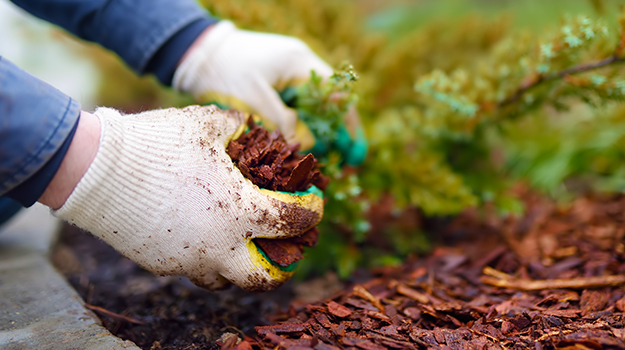
Mulching is one of the simplest and most common methods of protecting plants during the winter. It is used to protect plant roots that are less resistant to the cold or that are growing in a wind-swept area where snow does not accumulate much.
By applying 10 to 15 cm of organic matter (cedar mulch, decorative bark, cocoa hulls) over the root zone, you can prevent the cold from causing damage to the roots and crown of your plants.
Wait for the first frost on the ground before covering the root zone of perennials with mulch. Avoid covering the trunk of trees and shrubs. You can remove the mulch as soon as the soil thaws in the spring.
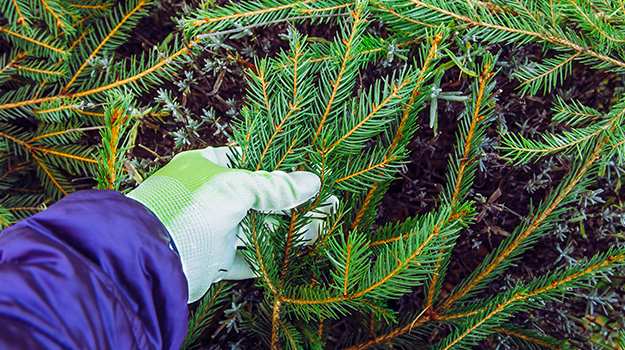
Here are other options for protecting plants that do not require elaborate winter protection.
- Use the foliage of a plant or a layer of shredded dead leaves to create a protective barrier against the cold.
- Make a teepee with fern fronds or conifer branches. They help retain snow and are aesthetically pleasing!
- Promote snow accumulation by leaving the stems and faded foliage of perennials until spring.
PLEASE NOTE: Unpacked snow is relatively light and insulates well. A greater number of plants can be protected in regions that benefit from a good snow cover.
The protective structure
Installing complete protection in 4 easy steps
Properly installed protection shelters both the roots and the aerial part of the plant. Here's how to install complete protection in 4 easy steps:
- Cover the base of the plant with a layer of mulch which will protect the roots from alternating periods of freezing and thawing.
- Hammer four to five stakes in the ground around the plant.
- Surround the stakes with a securely attached section of snow fence.
- Wrap the snow fence with burlap and use a staple gun to hold it in place.
The location of the stakes
The stakes and the snow fence serve as support for the burlap, to create a functional shelter for one or more plants. Make sure air can circulate to avoid any mold problems and disease. The wrap should never touch the plants since it conducts the cold. This barrier keeps salt spray from passing through.
Other types of winter protection
The use of cones
Polystyrene cones are very useful. They install in no time and help protect not only rose bushes, but also dwarf plants and young plants. However, you must remember to drill a few holes to ensure air circulation.
Nets
Nets can be used to tie up shrubs likely to be trodden under the weight of the snow or whose branches could be broken by icy conditions. If you don't have a net, you can use natural fibre twine.
Protections to avoid
Avoid plastic shields. This material prevents plants from breathing, causes excessive condensation and traps moisture. This results in a buildup of ice and freeze-dried leaves, and eventually the plants rot.
Also prefer light-coloured materials to dark-coloured ones which absorb heat.
How to protect rose bushes in winter
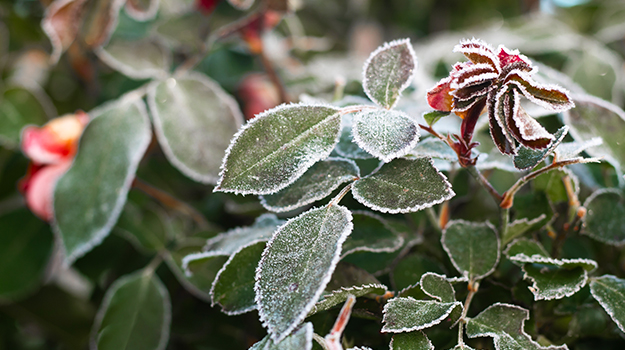
Before sheltering the rose bushes, wait until all leaves have fallen, remove all the leaves from the ground to avoid any potential diseases next spring, cut the plant so it can fit in the cone and cover the plant. Pierce the cones in different locations to allow air movement and avoid mold problems.
Climbing roses, like non-hardy climbing plants, must be detached from their trellis, laid flat down on the ground and covered with mulch or suitable protection.
Hardy roses do not require any protection. However, it is preferable to cover the graft union with peat moss, mulch or soil to protect it from the cold in case it is less hardy. You can also place mulch at their base to protect the roots from the cold.
For more advice and to discover varieties that do not require any winter protection, read our articles:
How to choose roses
25 Easy, low-maintenance roses
How to protect young trees and fruit trees during winter?
It is common for young trees and fruit trees to fall prey to rodents when food is scarce. Metal mesh and spirals of perforated white plastic prevent rabbits, voles and other small rodents from nibbling on their trunks and branches.
Winter protection of evergreens
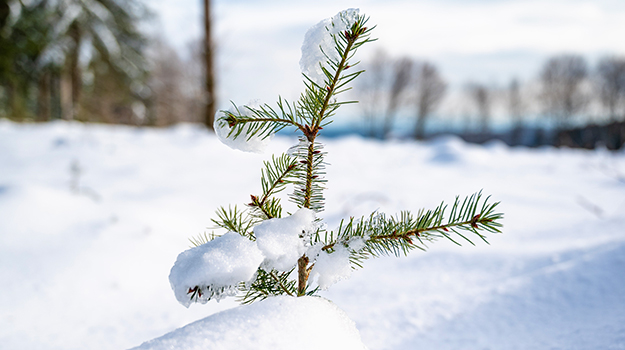
Evergreens resist harsh winters better than any other plants. However, as their permanent needles require a large amount of water, they must stock up. During the fall, water them well before freeze-up. This will help them store moisture to better resist drying winds.
Wrap erect evergreens with black or transparent netting, or hold the branches against the trunk with natural fibre twine. This prevents the crown from opening and the branches from bending under the weight of snow or ice. Do not over-tighten so you can allow air to circulate, and the centre of the plant can repel moisture. Otherwise, you may risk the chance of disease.
PRO TIP: If you use twine, tie it to a lower branch first and wrap it around the plant as you go, working your way up until it forms an upward cone.
Also install stakes for evergreens located near the house or under the roof to prevent them from being damaged by snow and ice accumulation. To protect them from the wind, surround them with wooden snow fencing. Solid and airy, these are used to surround the base of large evergreens or to form shelters that completely cover globe-shaped conifers.
TIP: Quick to install, polystyrene foam rose cones are perfect for young plants and dwarf conifers as long as they have ventilation holes.
Other tips to help your plants get through winter
- Gather your equipment in advance: nets, natural fibre twine, plastic spiral or mesh, wooden snow fence, synthetic protective canvas, burlap, polystyrene cones.
- Winter fences made from cedar slats are preferable to those made from soft wood, which rots, or spruce, which is brittle. They are lightweight, more robust and resistant to rot.
- To prevent their roots from freezing, plants grown in containers must be buried, with or without their pot.
- Avoid walking on the lawn when it is dormant. Otherwise, the grass will be slower to recover in the spring. Clear the sidewalks to encourage your guests to use them and do not park vehicles on the lawn. For more tips on winter lawn care, check out: Caring for Lawns in Winter | C-I-L Lawn and Garden (cillawnandgarden.com)
When should winter protection be removed?
Remove winter protection in early spring, in March or early April, depending on the region and temperature. Remove the mulch that protects perennials and unwrap trees and shrubs to avoid rotting or early bud burst.
Proceed on a cloudy day. This will protect your plant from the shock of sudden exposure to the sun.
Remove the covers and cones quickly if there is a warm spell and a risk of overheating, this to avoid the risk of mold. It will always be possible to put them back in place in the event of late frost.
How to avoid the chore of winter protection
Is installing winter protection a chore for you? Grow plants well suited to your climate and plant them in the right place. They will survive the winter without requiring any protection.
- Choose plants adapted to the growing conditions and hardiness zone of your garden.
- Avoid placing a less hardy plant in an area swept by the prevailing winds.
- Refrain from planting shrubs along the side of the street where they will be exposed to de-icing salts and the snowplow.
- Define a place – far from fragile plants – where the snowblower and snowplow can blow away the snow without damaging anything.
- Identify microclimates on your property, areas protected from winds and snow accumulation, places less prone to early freezes and late thaws... They will be better suited to more fragile plants.


